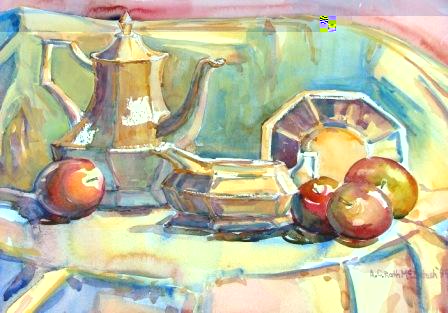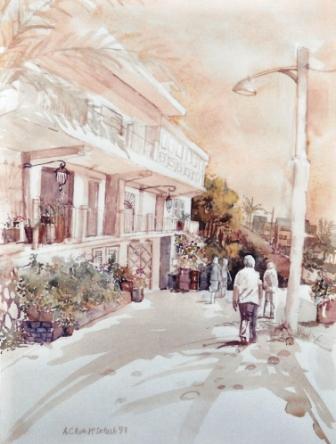WorldArtTours.net Online
Painting Workshop
You will see that my paintings have a few of the different watercolour techniques in them. |
Watercolour
Techniques
do even horizontal sweeps of colour and repeat as go down. The buildings on left were layered with flat washes.
2.Graded Wash- same as flat wash but dip in water at the end of each row instead of colour mix. Do not touch a painted area with the brush a second time or you'll get uneven colours and backruns. Turn the paper and put lightest side on bottom before you paint. See the sky go from dark to light on right in the bridge scene.
3.Lost and Found edges-
4.Dry Brush- the paper is left dry and then the paint stays where it is placed by a dry brush, one that has relatively little water to pigment. It is good to do individual branches or blades of grass with a pointed brush.
Hold a relatively dry wide wash brush on its side and drag over the surface of the paper to give a mottled weathered stucco textured look. This is an excellent technique for giving sparkle on water, beach shorline, roads. See the dry brush on the clothes of the people in the San Francisco market and on the tent roof.
5. Wet-in-Wet
This technique requires a paper that is wet. Wait for the shine to disappear on the wet paper for more controlled holding of shape painted with soft edges. Then apply the paint which should be of a richer thicker mix
 again if you wish the shape to hold a bit better. Tip the paper around and move back
and forth to mix the paint if really wet. This is an excellent technique for
backgrounds where items should be out of focus or a lovely blending of
colour. The sky in the Dutch scene and the cloth and background
in the still life on the right are wet-in-wet.
again if you wish the shape to hold a bit better. Tip the paper around and move back
and forth to mix the paint if really wet. This is an excellent technique for
backgrounds where items should be out of focus or a lovely blending of
colour. The sky in the Dutch scene and the cloth and background
in the still life on the right are wet-in-wet.6. Negative Painting-
 You don't paint the object.
You don't paint the object. Instead you paint around it with darker colours so it shows up. for example a person or a tree or branch surrounded by dark. The white umbrellas in the Chinese scene on the left were painted using the negative technique as was the man in the white shirt to the right on the Mexican Street scene from Bucerias